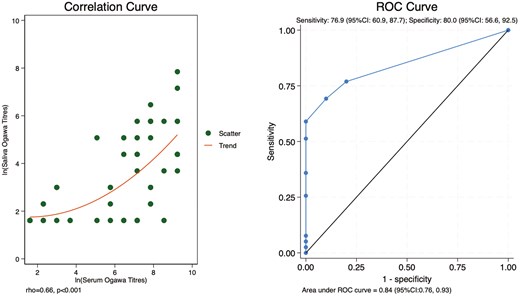-
Views
-
Cite
Cite
Caroline C Chisenga, Bernard Phiri, Harriet Ng’ombe, Mutinta Muchimba, Fraser Liswaniso, Biana Bernshtein, Adam F Cunningham, David Sack, Samuel Bosomprah, Diagnostic accuracy of saliva-based testing as a Vibrio cholerae surveillance tool among naturally infected patients, Clinical and Experimental Immunology, Volume 219, Issue 1, 2025, uxae092, https://doi.org/10.1093/cei/uxae092
Close - Share Icon Share
Abstract
Saliva, as a diagnostic medium, offers a promising alternative to blood by virtue of its non-invasive collection, which enhances patient compliance, especially in paediatric and geriatric populations. In this study, we assessed the utility of saliva as a non-invasive medium for measuring Vibrio cholerae-specific serum antibodies in naturally infected individuals. We tested paired serum and saliva samples obtained from a total of 63 patients with cholera enrolled in a cohort study. Vibriocidal antibodies assay (IgM/IgG) as markers for accurate determination was used to determine cholera-specific antibody levels. Using receiver operating characteristics (ROC) curve, we found that the best cut-off that maximizes (sensitivity + specificity) is 10 titres. At this saliva titre, the sensitivity is 76.9% (95%CI: 60.9%, 87.7%) and specificity is 80.0% (95%CI: 56.6%, 92.5%). Using Spearman’s correlation coefficient, we also found evidence of a positive correlation between V. cholerae saliva and serum antibodies (rho = 0.66, P < 0.001). In conclusion, saliva-based diagnostic cholera tests have high diagnostic accuracy and would be advantageous, cheaper, and quicker for early diagnosis of severe cholera outcomes.






